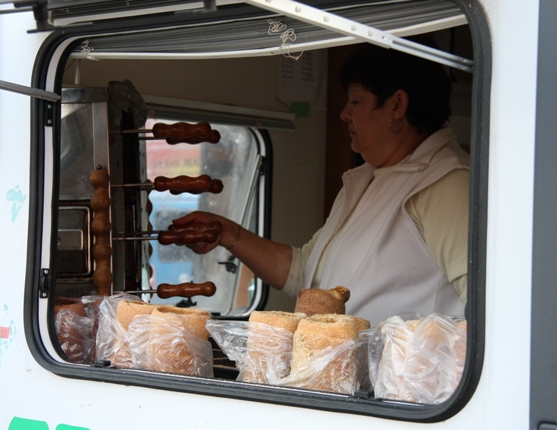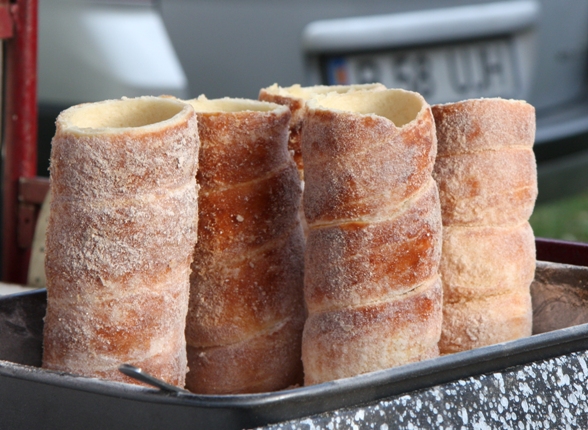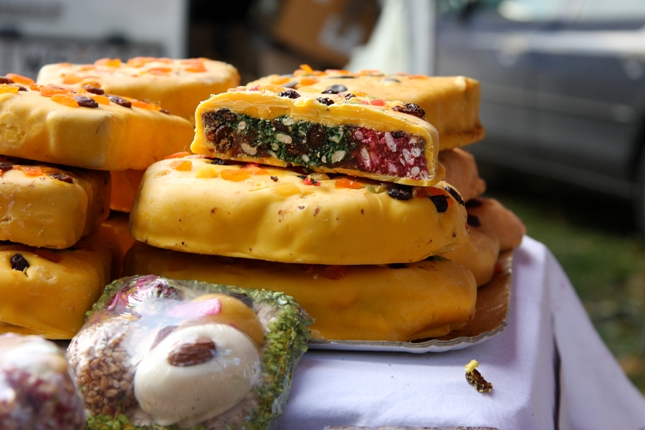 Once a year every town and village has its fair. In the town they are called “vásár” and villages have “búcsú”. Fairs were always a big part of the social life. If I have to use modern terminology then I would call it “social networking on a high level”. That was the time when the most important news were announced, the best gossip shared and the most vital items bought. Unfortunately socialism killed the vásár spirit and turned it into a big drunken party with boring rides for the kids. The situation after the Velvet Revolution did change, but not for better. The rides and beer stands were supplemented with cheap clothing stalls and companies presenting miracle knives, peelers and waxes. People want more, and things are changing again, for better this time. Fairs start to look like the ones my grandfather described, with stands offering honey-cake hearts, pottery, kitchen supplies, traditional food, candies, crazy guys selling charms and “flea circuses”. Many things are modernized, like never-ending stands with gummy sweets, but these things keep the Central European fair spirit alive.
Once a year every town and village has its fair. In the town they are called “vásár” and villages have “búcsú”. Fairs were always a big part of the social life. If I have to use modern terminology then I would call it “social networking on a high level”. That was the time when the most important news were announced, the best gossip shared and the most vital items bought. Unfortunately socialism killed the vásár spirit and turned it into a big drunken party with boring rides for the kids. The situation after the Velvet Revolution did change, but not for better. The rides and beer stands were supplemented with cheap clothing stalls and companies presenting miracle knives, peelers and waxes. People want more, and things are changing again, for better this time. Fairs start to look like the ones my grandfather described, with stands offering honey-cake hearts, pottery, kitchen supplies, traditional food, candies, crazy guys selling charms and “flea circuses”. Many things are modernized, like never-ending stands with gummy sweets, but these things keep the Central European fair spirit alive.

One of the most famous famous air foods all over the area is coiled cake. You can find it under different names. In Slovakia it runs under the name trdelnik, in Hungary it is kürtös kalacs. This tube-shaped cake originates in Transylvania (the Hungarian part of Romania). A strip of dough is coiled over a wooden pin, sugar sprinkled over it and then grilled over a heat source. Once the sugar has caramelized, the kürtös kalacs is dipped into ground walnuts. Modern versions might be dipped into cocoa powder, vanilla sugar, etc. If you have a chance, try to get one which is grilled over charcoals – it makes a difference.

Other traditional food item is medovník/mézeskalács, spice cookies. Buy a Huszár (soldier) for your son, a dolly for your daughter and heart for your wife or girlfriend. Nowadays you can get all shapes and forms, although I could not find a huszár (my son did pick out a large tank-shaped balloon, though). Mostly they have only sentimental value. You can eat them and we did, but you will not experience any gourmet revelation. We’ve posted a recipe, so you can experiment with making a more delicious version yourself.

A new fair item is zsanna-manna products. These sweets are made of dried fruits, nuts and seeds. They are handmade, taste and look great.


Sugar candies and lollipops are a very old tradition at the fair. The funny thing is that regardless of the color, they all taste the same. They are part of my caramel-sweet childhood.

This is the modern version of candy stands. Rows of candy and gummy sweets, providing good income and happy times for local dentists.

And finally my favorite. Lacikonyha. Lacikonyha means “Lászlo’s kitchen”. I dont know why is it called this way, and I don’t know Laci, but since the fifteenth century, fair tents where they cook different types of meals are called lacikonyha. These latest ones replace the former cheap-looking and disgusting caravans offering the same stuff with a grain of dirt and arrogant service. I don’t know why that is, but the chefs at lacikonyha are almost always happy, full of enthusiasm and always ready to joke with you.

A good surprise was the famous smoked Parenica cheese from northern Slovakia.




4 Responses
Great article, I’ll have to visit one day. When is this fair exactly?
you have just missed it :). it was last weekend. Usually it is end of October/beginning of November. But the Christmas fairs are starting soon. When kids will cooperate we would like to visit the Bratislava, Budapest and Vienna ones and compare them.
Several years ago we were in Budapest just before Christmas and were there during their “Fest”……..we really enjoyed the coiled cakes and hope to go back again sometime.
Komárom, “kis Komárom, nagy Komárom” as the song goes … the town was split in two by the Treaty of Versailles … 🙁
Bulk of the city is now in Slovakia, but with a 60% Hungarian population.
The fair looks wonderful, a dying tradition in many small towns …
For a year round experience of hot Magyar market stall food and cakes the central market (Vásárcsarnok) in Budapest is hard to beat !